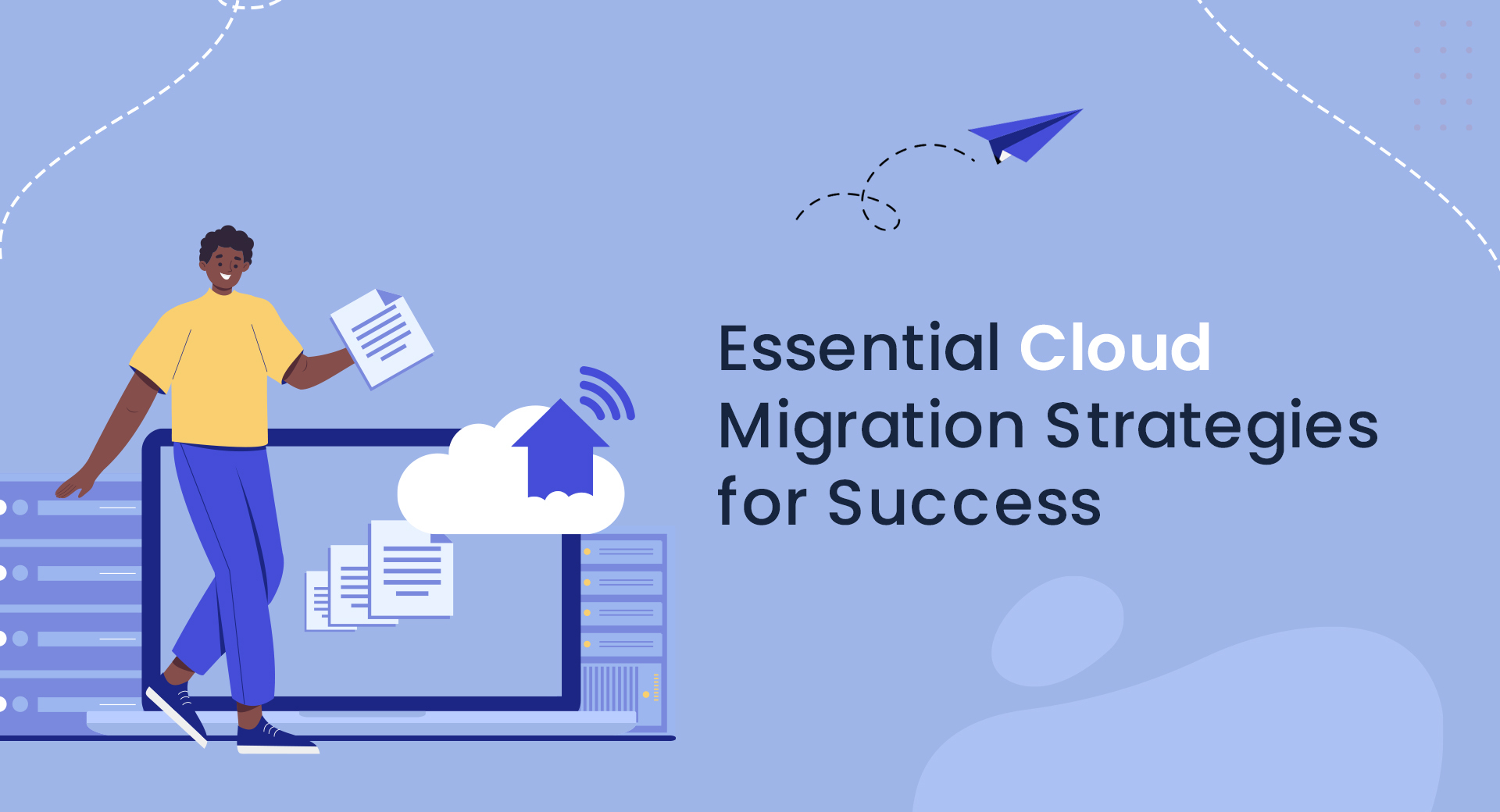Key Highlights
- Cloud migration is the process of moving data, applications, and workloads from on-premises data centers to a cloud-based infrastructure or from one cloud environment to another.
- Cloud migration offers several benefits, such as business continuity, cost savings, scalability, and access to advanced cloud capabilities.
- Overcoming common cloud migration challenges, such as data security and compliance issues, and mitigating downtime, requires proper strategies and measures.
- Advanced cloud migration technologies and tools, such as AI and machine learning, containers, and microservices, play a crucial role in ensuring a smooth transition and planning for future post-migration strategies.
Understanding Cloud Migration: The What, Why, and How
Cloud migration is the process of moving data, applications, and workloads from on-premises data centers to a cloud-based infrastructure or from one cloud environment to another. It involves the transformation of an organization’s IT infrastructure and operations to a cloud-based model, utilizing various IT resources. This migration can be done to a single cloud or multiple clouds, depending on the organization’s needs and preferences.
Organizations migrate to the cloud for increased business value, agility, scalability, and flexibility. Cloud migration streamlines IT operations, enabling rapid resource deployment and reducing infrastructure management efforts. It enhances responsiveness to market changes and improves customer value delivery.
Cost savings are a significant benefit of cloud migration as it eliminates the need for on-premises data centers, leading to savings on hardware, software, and maintenance costs. The pay-as-you-go pricing model optimizes expenses by charging only for resources used. Cloud migration also offers access to advanced capabilities like data analytics, artificial intelligence, machine learning, and IoT services. Further, these tools help automate processes, unlock insights, and enhance decision-making.
Successful cloud migration involves assessing the current environment, defining business goals, selecting appropriate cloud service models, planning and executing the migration process, and optimizing post-migration maintenance.
Key Benefits of Migrating to the Cloud
Migrating to the cloud offers several key benefits for organizations.
Firstly, it ensures business continuity by providing reliable and resilient infrastructure. Cloud service providers offer built-in redundancy and disaster recovery capabilities, minimizing the risk of downtime and data loss. This ensures that critical business operations can continue even in the event of a disaster or system failure.
Secondly, cloud migration can result in substantial cost savings. Organizations can eliminate the need for expensive on-premises infrastructure and reduce hardware and software maintenance costs. Cloud services also follow a pay-as-you-go pricing model, enabling organizations to pay only for the resources they use.
Scalability is another significant benefit of cloud migration. Cloud environments allow organizations to easily scale resources up or down based on demand. This flexibility ensures that organizations can meet changing business needs and avoid overprovisioning or underutilization of resources.
Lastly, cloud migration provides access to advanced cloud capabilities. Cloud service providers offer a wide range of services, including data analytics, artificial intelligence, machine learning, and IoT services. These capabilities enable organizations to leverage their data, automate processes, and gain valuable insights to drive business growth and innovation.
Overall, migrating to the cloud offers organizations improved business continuity, cost savings, scalability, and access to advanced cloud capabilities, making it a compelling choice for organizations looking to modernize their IT infrastructure.
Additionally, check out an article on Performance Optimization Essentials for Scaling Up.
Preparing for Cloud Migration: A Step-by-Step Approach
Cloud migration preparation requires a structured approach to ensure a smooth transition. This involves assessing current infrastructure, defining business goals, and choosing the appropriate cloud service and deployment models. Hence, this phase, known as migration planning, lays the groundwork for a successful migration by mitigating risks and optimizing the process. Let’s delve into the key steps for cloud migration preparation.
Assessing Your Current Infrastructure
Assess your current infrastructure as the first step in preparing for cloud migration. This helps you understand your organization’s environment, identify legacy systems that need attention, and evaluate infrastructure readiness for the transition to a new cloud setup. Key aspects to consider during this assessment include:
- Take an inventory of your current infrastructure, including servers, networking equipment, storage systems, and applications.
- Identify any legacy systems or technologies that may require special attention during the migration process.
- Evaluate the capacity and performance of your current data center and determine if any upgrades or modifications are needed.
- Assess the compatibility of your applications and data with cloud infrastructure and services.
- Evaluate the security measures in place and identify any potential vulnerabilities or compliance issues.
Furthermore, conducting a thorough assessment of your current infrastructure helps determine your organization’s migration readiness and make informed decisions for a successful cloud migration.
Identifying Business Goals and Objectives
Assessing your infrastructure is crucial for cloud migration. Identify your business goals to align the migration strategy with your overall objectives and meet security requirements. Key considerations include:
- Clearly define your business objectives for cloud migration, such as improving agility, reducing costs, or enhancing user experience.
- Develop a business case that outlines the benefits and ROI of cloud migration for your organization.
- Define your cloud strategy, including the cloud service model (IaaS, PaaS, SaaS) and deployment model (public, private, hybrid) that best meet your business needs.
- Consider the impact of cloud migration on your users and stakeholders and ensure that their needs and expectations are addressed.
- Establish key performance indicators (KPIs) to measure the success of your cloud migration and track progress towards your business goals.
Thus, by identifying your business goals and objectives, you can create a clear roadmap for cloud migration and ensure that your migration strategy is aligned with your organization’s overall strategy.
The Core Strategies for Successful Cloud Migration
To succeed in cloud migration, organizations must adopt core strategies that address key considerations like choosing the right cloud service and deployment models. These strategies lay the groundwork for a well-planned migration, including legacy application transition, ensuring optimal outcomes. Let’s delve into these essential strategies for successful cloud migration.
Selecting the Right Cloud Service Model (IaaS, PaaS, SaaS)
Selecting the right cloud service model is crucial for successful cloud migration. The three main models are Infrastructure as a Service (IaaS), Platform as a Service (PaaS), and Software as a Service (SaaS). Each model varies in control and responsibility levels, giving organizations flexibility to customize as needed. For instance, migrating applications to a SaaS platform like Salesforce can be cost-effective.
- Infrastructure as a Service (IaaS): With IaaS, organizations have complete control over the underlying infrastructure, including servers, storage, and networking. They can manage and deploy their own applications and operating systems on the cloud infrastructure.
- Platform as a Service (PaaS): PaaS provides a platform for developing, testing, and deploying applications. It offers a higher level of abstraction, allowing organizations to focus on application development without worrying about infrastructure management.
- Software as a Service (SaaS): SaaS provides ready-to-use applications that are accessible over the Internet. Organizations can use these applications without worrying about infrastructure or software maintenance.
When choosing a cloud service model, organizations should consider their business needs, technical requirements, and desired level of control and customization. Lst;y, this decision will influence the migration strategy, required resources, and skills for a successful transition.
Choosing Between Public, Private, or Hybrid Cloud
Organizations must choose the right cloud deployment model in addition to the service model. The main options are public, private, and hybrid clouds. Each model offers varying levels of control, security, and scalability to meet specific business needs.
- Public Cloud: Public cloud services are delivered over the internet by third-party cloud service providers. They offer scalability and cost-effectiveness, as resources are shared among multiple organizations.
- Private Cloud: Private cloud services are dedicated to a single organization and can be hosted on-premises or by a third-party provider. They offer enhanced security and control, making them suitable for organizations with strict data privacy and compliance requirements.
- Hybrid Cloud: Hybrid cloud combines public and private cloud services, allowing organizations to leverage the benefits of both models. It offers flexibility, scalability, and cost optimization, as organizations can choose where to deploy each workload based on specific requirements.
When choosing cloud options (public, private, or hybrid), organizations must consider security, compliance, scalability, and cost. Aligning the deployment model with business needs and IT infrastructure is crucial for a successful cloud migration.
Here’s an article on Healthcare Cybersecurity: Protecting Patient Data, check it out!
Overcoming Common Cloud Migration Challenges
Cloud migration poses challenges that organizations must overcome for a successful transition. By addressing these challenges with proper strategies, organizations can optimize the process and minimize risks. Let’s delve into common cloud migration challenges and solutions.
Handling Data Security and Compliance Issues
Data security and compliance are key concerns when migrating to the cloud. Organizations need to ensure the confidentiality, integrity, and availability of their data and comply with relevant regulatory requirements. Here are some strategies to handle data security and compliance issues during cloud migration:
- Implement robust security measures, such as encryption, access controls, and user authentication, to protect sensitive data in transit and at rest.
- Conduct a thorough risk assessment and identify potential vulnerabilities and threats in the cloud environment.
- Ensure compliance with relevant regulations, such as HIPAA or GDPR, by working with cloud service providers that offer compliant solutions.
- Develop and enforce data governance policies and procedures to ensure data privacy and compliance with industry standards.
- Regularly monitor and audit the cloud environment to detect and respond to any security incidents or breaches.
By addressing data security and compliance issues during cloud migration, organizations can ensure the protection of their sensitive data and maintain regulatory compliance.
Mitigating Downtime During Migration
Downtime during cloud migration can disrupt business operations and result in financial losses. Mitigating downtime requires careful planning and execution. Here are some strategies to minimize downtime during migration:
- Develop a comprehensive migration plan that includes a detailed timeline, resource allocation, and risk mitigation strategies.
- Conduct thorough testing and validation of applications and data in the new cloud environment before the actual migration.
- Implement disaster recovery and business continuity measures to ensure minimal disruption in the event of system failures or data loss.
- Prioritize workloads based on criticality and migrate them in a phased approach, starting with low-risk and non-essential workloads.
- Establish effective communication and collaboration channels to keep stakeholders informed and address any issues or concerns promptly.
By implementing these strategies, organizations can minimize downtime during cloud migration and ensure a smooth transition to the new cloud environment.
Want a consultation on Blockchain? We are here to help you!
Best Practices for Cloud Migration
For a successful cloud migration, organizations should follow best practices like automation, continuous monitoring, and optimization. Incorporating these practices can optimize resources, enhance performance, and cut costs during migration. Let’s delve into some key strategies for cloud migration.
Incorporating Automation and DevOps
Automation and DevOps streamline cloud migration and maximize cloud benefits. By integrating them into migration strategies, organizations achieve faster deployment, reduce errors, and enhance collaboration between teams. Here are some best practices:
- Implement continuous integration and continuous delivery (CI/CD) pipelines to automate the build, test, and deployment processes.
- Leverage infrastructure as code (IaC) tools, such as Terraform or AWS CloudFormation, to automate the provisioning and configuration of cloud resources.
- Use containerization technologies, such as Docker, to ensure consistency and portability of applications across different cloud environments.
- Adopt DevOps practices, such as collaboration, continuous monitoring, and iterative development, to improve efficiency and productivity throughout the migration process.
By incorporating automation and DevOps practices, organizations can accelerate their cloud migration, reduce manual efforts, and ensure consistency and scalability in their cloud environments.
Continuous Monitoring and Optimization
Continuous monitoring and optimization are crucial for cloud resource performance and cost-effectiveness. Organizations can ensure optimal performance and cost control by monitoring applications and infrastructure continuously, as well as optimizing resource utilization. Here are some best practices:
- Implement performance monitoring tools to track the health and performance of applications and infrastructure in real time.
- Use cloud cost management tools to monitor and analyze cloud costs, identify cost optimization opportunities, and optimize resource utilization.
- Conduct periodic performance and cost reviews to identify areas for improvement and take proactive measures to optimize performance and reduce costs.
- Leverage cloud-native services, such as auto-scaling and load balancing, to optimize resource allocation and ensure optimal performance.
By continuously monitoring and optimizing cloud resources, organizations can ensure high performance, cost efficiency, and a positive user experience.
Case Studies: Real-World Cloud Migration Success Stories
Real-world case studies offer insights into successful cloud migration, showcasing the benefits for organizations. Let’s delve into some success stories and their impact on businesses.
Industry-Specific Migration Insights
Each industry faces unique challenges and opportunities in cloud migration. Industry-specific insights offer valuable guidance and best practices for organizations planning their migration. Here are some key insights:
- Healthcare: Cloud migration enables healthcare organizations to enhance patient care, improve data security, and streamline operations by leveraging cloud computing power and capabilities.
- Financial Services: Cloud migration allows financial institutions to improve agility, scalability, and data security while complying with strict regulatory requirements.
- Retail: Cloud migration enables retailers to scale their infrastructure based on demand, optimize supply chain management, and enhance customer experience through personalized services and recommendations.
- Manufacturing: Cloud migration helps manufacturers improve operational efficiency, reduce costs, and leverage advanced analytics and IoT capabilities for predictive maintenance and supply chain optimization.
By understanding industry-specific migration insights, organizations can tailor their migration strategies to address the unique challenges and opportunities in their respective industries.
Lessons Learned and Key Takeaways
Cloud migration is a continuous learning process, and organizations can benefit from the lessons learned and key takeaways from previous migration projects. Here are some lessons learned and key takeaways:
- Planning and preparation are crucial for a successful migration. Thoroughly assess your current infrastructure, clearly define your business goals and objectives, and develop a detailed migration plan.
- Address data security and compliance early in the migration process to ensure regulatory compliance and protect sensitive data.
- Mitigate downtime by conducting thorough testing and validation, prioritizing workloads, and establishing effective communication channels.
- Incorporate automation and DevOps practices to streamline the migration process and improve collaboration between development and operations teams.
- Continuously monitor and optimize cloud resources to ensure optimal performance and cost control.
By applying these lessons learned and key takeaways, organizations can enhance their cloud migration strategies and achieve successful outcomes.
Advanced Cloud Migration Technologies and Tools
Advanced cloud migration technologies and tools are essential for a smooth transition and future planning. They help enhance the migration process, optimize cloud resources, and drive innovation. Let’s explore some of these technologies and tools.
Utilizing AI and Machine Learning for Smoother Transitions
AI and machine learning enhance cloud migration by automating tasks, offering insights, and predicting challenges. Organizations can use these technologies for smoother transitions by:
- Use AI-powered migration assessment tools to analyze the current infrastructure, identify dependencies, and recommend the best migration strategies.
- Apply machine learning algorithms to automate the discovery and classification of data, making it easier to migrate and manage data in the cloud.
- Utilize AI-powered monitoring and analytics tools to detect anomalies, predict performance issues, and optimize resource allocation in real time.
By leveraging AI and machine learning technologies, organizations can improve the efficiency and effectiveness of their cloud migration process, ensuring a smoother transition to the cloud.
The Role of Containers and Microservices in Cloud Migration
Containers and microservices are key architectural concepts crucial for cloud migration. They enhance scalability, flexibility, and portability of applications.
- Containers provide a lightweight and portable environment for packaging and deploying applications, making it easier to migrate applications between different cloud environments.
- Microservices architecture enables organizations to break down their applications into smaller, independent services, facilitating modular development, scalability, and continuous deployment.
- Serverless computing leverages microservices to enable organizations to run applications without managing infrastructure, reducing operational overhead and increasing scalability.
By embracing containers, microservices, and serverless computing, organizations can optimize their cloud migration and maximize the benefits of cloud-native architectures.
Planning for the Future: Post-Migration Strategies
Planning for the future is crucial for maximizing cloud migration benefits and ensuring long-term success. Post-migration strategies prioritize scalability, flexibility, and cloud resource optimization. Let’s delve into key considerations for post-migration strategies.
Ensuring Scalability and Flexibility
Cloud migration offers scalability and flexibility. Organizations must ensure their cloud resources can adapt to evolving business needs and growth. Here are strategies for ensuring scalability and flexibility:
- Leverage cloud-native services, such as auto-scaling and load balancing, to automatically adjust resource allocation based on demand.
- Implement elastic architectures that can easily accommodate increased workloads and traffic.
- Continuously monitor resource utilization and performance to identify bottlenecks and optimize resource allocation.
- Adopt serverless computing to abstract infrastructure management and focus on developing and deploying scalable applications.
By ensuring scalability and flexibility in the cloud environment, organizations can future-proof their infrastructure and effectively support business growth and changing demands.
Cost Management and Optimization Post-Migration
Cost management and optimization are critical post-migration strategies to ensure cost-effectiveness and maximize return on investment (ROI). Here are some strategies for cost management and optimization:
- Continuously monitor and analyze cloud costs to identify cost optimization opportunities and optimize resource utilization.
- Leverage cloud cost management tools to track and allocate costs, set budgets, and implement cost-saving measures.
- Implement governance and management processes to monitor and control resource provisioning and usage.
- Regularly review and optimize cloud resources based on performance, cost, and business needs.
By implementing cost management and optimization strategies, organizations can reduce cloud costs, improve cost-effectiveness, and achieve better ROI on their cloud migration investment.
Conclusion
Successful cloud migration requires a comprehensive approach, from infrastructure assessment to service model selection and overcoming challenges like data security. Automation, continuous monitoring, and optimization are crucial for a smooth transition. Real-world case studies offer valuable insights for success. Leveraging AI, machine learning, and containers can enhance the process. Planning for post-migration scalability, flexibility, and cost optimization is essential. Contact us today for expert guidance on your cloud migration journey.
Frequently Asked Questions
What is the most cost-effective cloud migration strategy?
The optimal cloud migration strategy depends on factors like business needs, IT infrastructure, and desired outcomes. Rehosting (lift-and-shift) is a quick and straightforward migration method that minimizes costs by avoiding major architectural changes.
How long does the average cloud migration take?
The duration of a cloud migration project varies based on factors like infrastructure complexity, migration scale, and organization readiness. Typically, it can last from a few months to over a year, encompassing planning, execution, testing, and optimization phases
How to choose the right cloud provider for your needs?
When selecting a cloud provider, consider factors like business needs, technical requirements, security capabilities, pricing models, and service-level agreements. Evaluate multiple providers to find the best fit for your organization.



